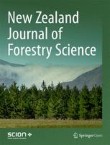Plantation species-specific adjustment functions for the Forest Carbon Predictor in New Zealand
New Zealand’s planted forest area is dominated by radiata pine (90%), but also includes Douglas-fir (6%), and a range of minor species including eucalypts and cypress. Carbon sequestration in planted forest is...
